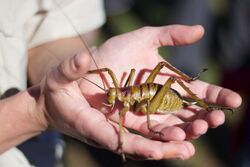Biology:Giant wētā
| Giant wētā | |
|---|---|

| |
| Wētāpunga (Deinacrida heteracantha) – overall length 20 cm (8 inches) | |
| Scientific classification | |
| Domain: | Eukaryota |
| Kingdom: | Animalia |
| Phylum: | Arthropoda |
| Class: | Insecta |
| Order: | Orthoptera |
| Suborder: | Ensifera |
| Family: | Anostostomatidae |
| Subfamily: | Deinacridinae |
| Genus: | Deinacrida White, 1842 |
| Species | |
|
See text | |
Giant wētā are several species of wētā in the genus Deinacrida of the family Anostostomatidae. Giant wētā are endemic to New Zealand and all but one species are protected by law because they are considered at risk of extinction.[1]
There are eleven species of giant wētā,[2] most of which are larger than other wētā, despite the latter also being large by insect standards. Large species can be up to 10 cm (4 in), not inclusive of legs and antennae, with body mass usually no more than 35 g (1.2 oz). One gravid captive female reached a mass of about 70 g (2.47 oz), making it one of the heaviest insects in the world[3] and heavier than a sparrow. This is, however, abnormal, as this individual was unmated and retained an abnormal number of eggs. The largest species of giant wētā is the Little Barrier Island giant wētā, also known as the wētāpunga.[4] One example reported in 2011 weighed 71 g (2.50 oz).[5]
Giant wētā tend to be less social and more passive than other wētā. Their genus name, Deinacrida, means "terrible grasshopper", from the Greek word δεινός (deinos, meaning "terrible", "potent", or "fearfully great"), in the same way dinosaur means "terrible lizard". They are found primarily on New Zealand offshore islands, having been almost exterminated on the mainland islands by introduced mammalian pests.
Habitat and distribution
Most populations of giant wētā have been in decline since humans began modifying the New Zealand environment. All but one giant wētā species is protected by law because they are considered at risk of extinction.[1] Three arboreal giant wētā species are found in the north of New Zealand and now restricted to mammal-free habitats. This is because the declining abundance of most wētā species, particularly giant wētā, can be attributed to the introduction of mammalian predators, habitat destruction, and habitat modification by introduced mammalian browsers. New populations of some wētā have been established in locations, particularly on islands, where these threats have been eliminated or severely reduced in order to reduce the risk of extinction.[6] Deinacrida heteracantha, and D. fallai are found only on near-shore islands that have no introduced predators (Te Hauturu-o-Toi and Poor Knights Island). The closely related species D. mahoenui is restricted to habitat fragments in North Island.[7]
Two closely related giant wētā species are less arboreal. Deinacrida rugosa is restricted to mammal-free reserves and D. parva is found near Kaikoura in South Island New Zealand.
Many giant wētā species are alpine specialists. Five species are only found at high elevation in South Island. The scree wētā D. connectens lives about 1,200 m (3,900 ft) above sea level [8] and freezes solid when temperatures drop below −5 °C (23 °F).[9]
Species list
- Deinacrida carinata, Herekopare wētā
- Deinacrida connectens, Scree wētā
- Deinacrida elegans, Bluff wētā
- Deinacrida fallai, Poor Knights giant wētā
- Deinacrida heteracantha, Little Barrier Island giant wētā
- Deinacrida mahoenui, Mahoenui giant wētā
- Deinacrida parva, Kaikoura giant wētā
- Deinacrida pluvialis, Mt Cook giant wētā
- Deinacrida rugosa, Cook Strait giant wētā
- Deinacrida talpa, Giant mole wētā
- Deinacrida tibiospina, Mt Arthur giant wētā
References
- ↑ 1.0 1.1 Trewick, S (2012). "The conservation status of New Zealand Orthoptera". New Zealand Entomologist 35 (2): 131–136. doi:10.1080/00779962.2012.686318.
- ↑ Morgan-Richards, M (2001). "A phylogenetic analysis of New Zealand giant and tree wētā (Orthoptera : Anostostomatidae : Deinacrida and Hemideina) using morphological and genetic characters". Invertebrate Taxonomy 15: 1–12. doi:10.1071/IT99022.
- ↑ "Book of Insect Records". http://entnemdept.ufl.edu/walker/ufbir/chapters/chapter_30.shtml.
- ↑ Gibbs, George W. (2003). Weta. Morris, Rod, 1951-. Auckland [N.Z.]: Reed. ISBN 1-86948-604-8. OCLC 155944595. https://www.worldcat.org/oclc/155944595.
- ↑ "World's biggest insect is so huge it eats carrots". Telegraph. 2011-12-01. https://www.telegraph.co.uk/news/earth/wildlife/8930070/Worlds-biggest-insect-is-so-huge-it-eats-carrots.html.
- ↑ Watts, Corinne (Jul 2008). "History of weta (Orthoptera : Anostostomatidae) translocation in New Zealand: lessons learned, islands as sanctuaries and the future". Journal of Insect Conservation 12 (3–4): 359–370. doi:10.1007/s10841-008-9154-5. http://apps.webofknowledge.com/full_record.do?product=WOS&search_mode=GeneralSearch&qid=1&SID=7C4kTGdihNKlHZqE3Y1&page=1&doc=19&cacheurlFromRightClick=no.
- ↑ Field, L (2001). The Biology of wetas, king crickets and their allies. UK: CABI. ISBN 0851994083.
- ↑ Morgan-Richards, M (1996). "Colour, allozyme and karyotype variation in the New Zealand Giant Scree Weta Deinacrida connectens (Orthoptera: Stenopelmatidae)". Hereditas 125: 265–276. doi:10.1111/j.1601-5223.1996.00265.x.
- ↑ Sinclair, B (1999). "Insect cold tolerance: How many kinds of frozen?". European Journal of Entomology 96: 157–164.
External links
- Saving New Zealand's prehistoric giant weta. Earthrise, Al Jazeera English, June 2018 (video, 10:22 mins)
Wikidata ☰ Q3622155 entry
 |


